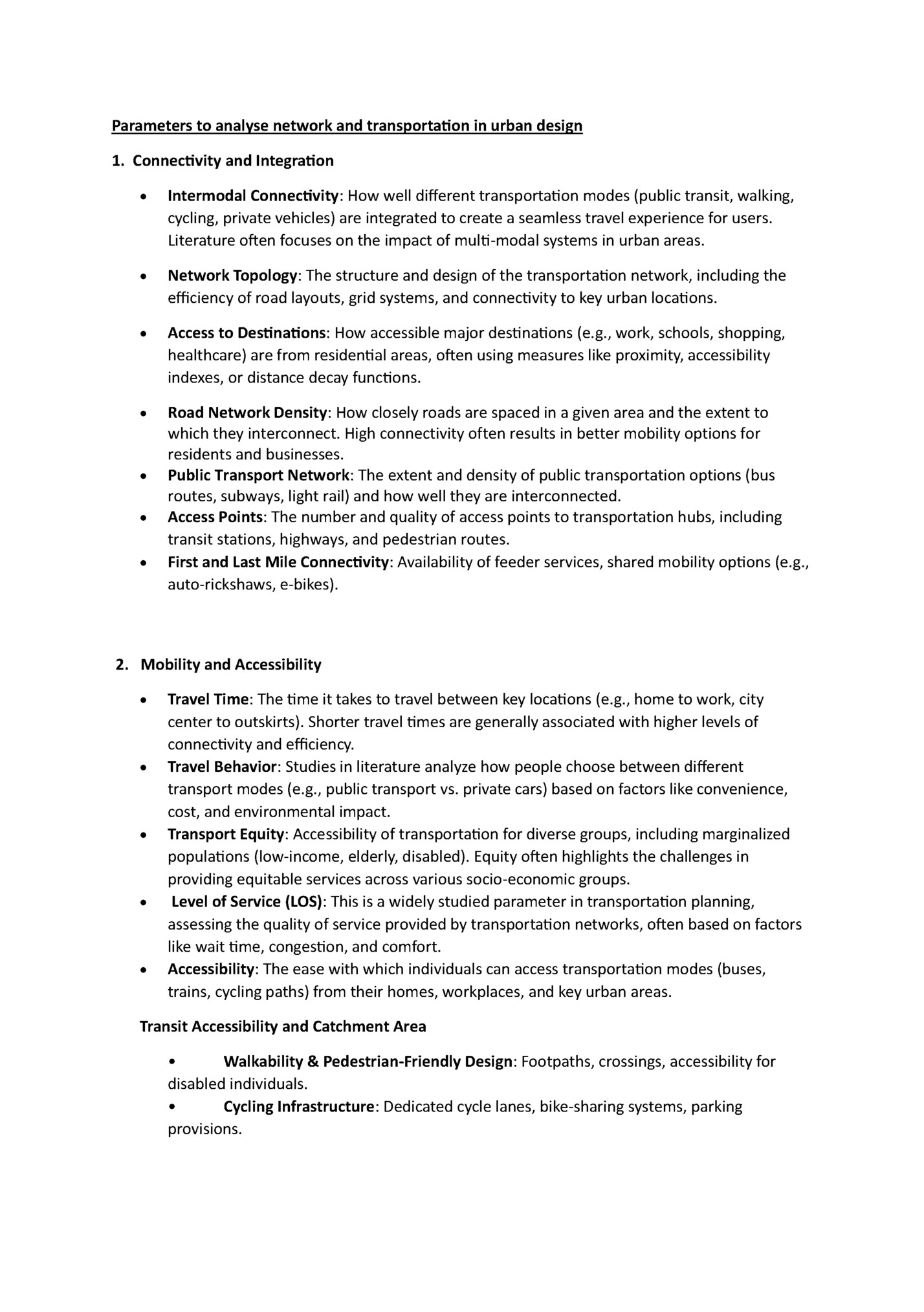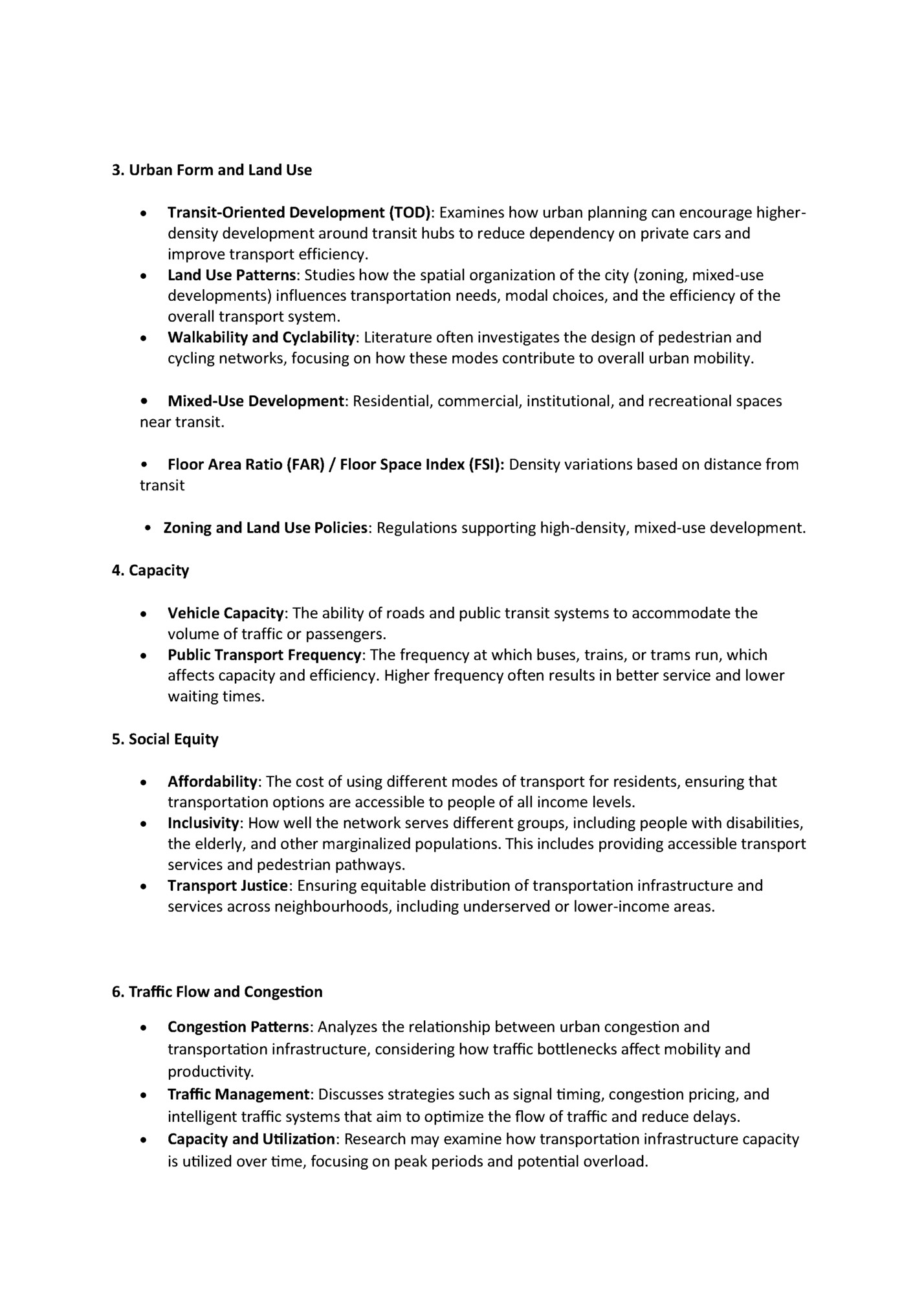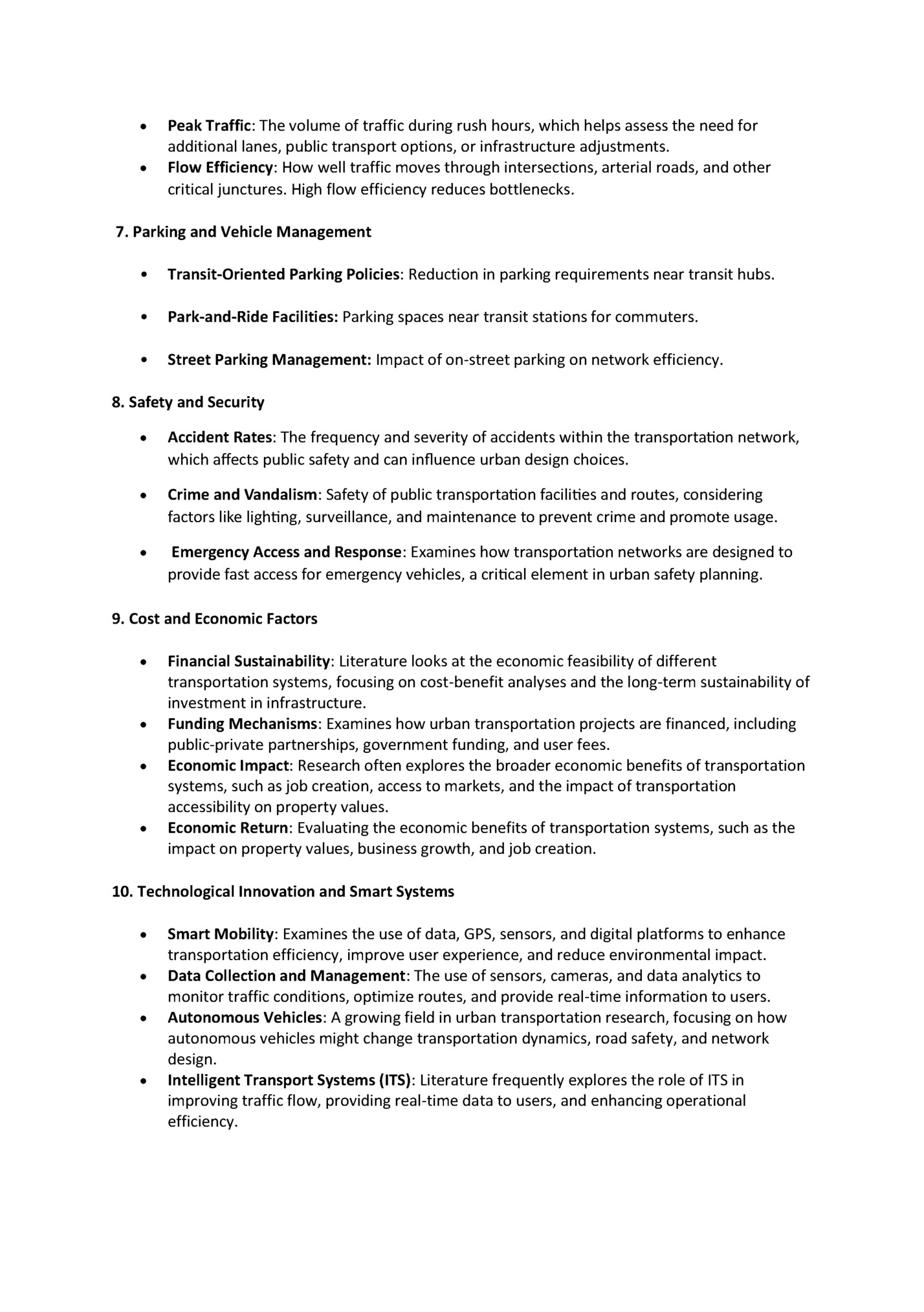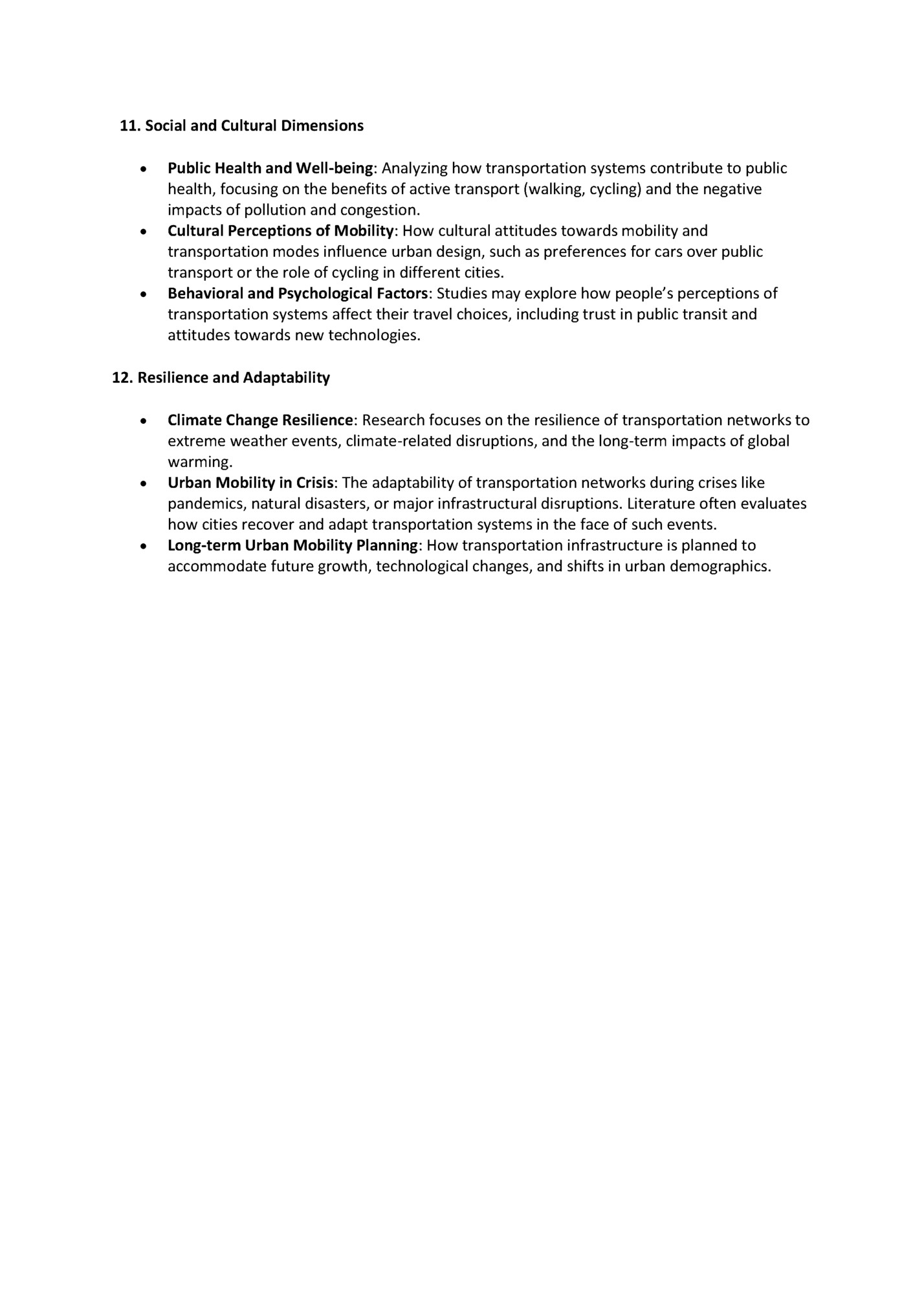1. Connectivity and Integration • Intermodal Connectivity: How well different transportation modes (public transit, walking, cycling, private vehicles) are integrated to create a seamless travel experience for users. Literature often focuses on the impact of multi-modal systems in urban areas. • Network Topology: The structure and design of the transportation network, including the efficiency of road layouts, grid systems, and connectivity to key urban locations. • Access to Destinations: How accessible major destinations (e.g., work, schools, shopping, healthcare) are from residential areas, often using measures like proximity, accessibility indexes, or distance decay functions. • Road Network Density: How closely roads are spaced in a given area and the extent to which they interconnect. High connectivity often results in better mobility options for residents and businesses. Public Transport Network: The extent and density of public transportation options (bus routes, subways, light rail) and how well they are interconnected. Access Points: The number and quality of access points to transportation hubs, including transit stations, highways, and pedestrian routes. First and Last Mile Connectivity: Availability of feeder services, shared mobility options (e.g., auto-rickshaws, e-bikes). • • • 2. Mobility and Accessibility • • • • • Travel Time: The time it takes to travel between key locations (e.g., home to work, city center to outskirts). Shorter travel times are generally associated with higher levels of connectivity and efficiency. Travel Behavior: Studies in literature analyze how people choose between different transport modes (e.g., public transport vs. private cars) based on factors like convenience, cost, and environmental impact. Transport Equity: Accessibility of transportation for diverse groups, including marginalized populations (low-income, elderly, disabled). Equity often highlights the challenges in providing equitable services across various socio-economic groups. Level of Service (LOS): This is a widely studied parameter in transportation planning, assessing the quality of service provided by transportation networks, often based on factors like wait time, congestion, and comfort. Accessibility: The ease with which individuals can access transportation modes (buses, trains, cycling paths) from their homes, workplaces, and key urban areas. Transit Accessibility and Catchment Area • Walkability & Pedestrian-Friendly Design: Footpaths, crossings, accessibility for disabled individuals. • Cycling Infrastructure: Dedicated cycle lanes, bike-sharing systems, parking provisions.

• • • Transit-Oriented Development (TOD): Examines how urban planning can encourage higherdensity development around transit hubs to reduce dependency on private cars and improve transport efficiency. Land Use Patterns: Studies how the spatial organization of the city (zoning, mixed-use developments) influences transportation needs, modal choices, and the efficiency of the overall transport system. Walkability and Cyclability: Literature often investigates the design of pedestrian and cycling networks, focusing on how these modes contribute to overall urban mobility. • Mixed-Use Development: Residential, commercial, institutional, and recreational spaces near transit. • Floor Area Ratio (FAR) / Floor Space Index (FSI): Density variations based on distance from transit • Zoning and Land Use Policies: Regulations supporting high-density, mixed-use development. 4. Capacity • • Vehicle Capacity: The ability of roads and public transit systems to accommodate the volume of traffic or passengers. Public Transport Frequency: The frequency at which buses, trains, or trams run, which affects capacity and efficiency. Higher frequency often results in better service and lower waiting times. 5. Social Equity • • • Affordability: The cost of using different modes of transport for residents, ensuring that transportation options are accessible to people of all income levels. Inclusivity: How well the network serves different groups, including people with disabilities, the elderly, and other marginalized populations. This includes providing accessible transport services and pedestrian pathways. Transport Justice: Ensuring equitable distribution of transportation infrastructure and services across neighbourhoods, including underserved or lower-income areas. 6. Traffic Flow and Congestion • • • Congestion Patterns: Analyzes the relationship between urban congestion and transportation infrastructure, considering how traffic bottlenecks affect mobility and productivity. Traffic Management: Discusses strategies such as signal timing, congestion pricing, and intelligent traffic systems that aim to optimize the flow of traffic and reduce delays. Capacity and Utilization: Research may examine how transportation infrastructure capacity is utilized over time, focusing on peak periods and potential overload.

• Peak Traffic: The volume of traffic during rush hours, which helps assess the need for additional lanes, public transport options, or infrastructure adjustments. Flow Efficiency: How well traffic moves through intersections, arterial roads, and other critical junctures. High flow efficiency reduces bottlenecks. 7. Parking and Vehicle Management • Transit-Oriented Parking Policies: Reduction in parking requirements near transit hubs. • Park-and-Ride Facilities: Parking spaces near transit stations for commuters. • Street Parking Management: Impact of on-street parking on network efficiency. 8. Safety and Security • Accident Rates: The frequency and severity of accidents within the transportation network, which affects public safety and can influence urban design choices. • Crime and Vandalism: Safety of public transportation facilities and routes, considering factors like lighting, surveillance, and maintenance to prevent crime and promote usage. • Emergency Access and Response: Examines how transportation networks are designed to provide fast access for emergency vehicles, a critical element in urban safety planning. 9. Cost and Economic Factors • • • • Financial Sustainability: Literature looks at the economic feasibility of different transportation systems, focusing on cost-benefit analyses and the long-term sustainability of investment in infrastructure. Funding Mechanisms: Examines how urban transportation projects are financed, including public-private partnerships, government funding, and user fees. Economic Impact: Research often explores the broader economic benefits of transportation systems, such as job creation, access to markets, and the impact of transportation accessibility on property values. Economic Return: Evaluating the economic benefits of transportation systems, such as the impact on property values, business growth, and job creation. 10. Technological Innovation and Smart Systems • • • • Smart Mobility: Examines the use of data, GPS, sensors, and digital platforms to enhance transportation efficiency, improve user experience, and reduce environmental impact. Data Collection and Management: The use of sensors, cameras, and data analytics to monitor traffic conditions, optimize routes, and provide real-time information to users. Autonomous Vehicles: A growing field in urban transportation research, focusing on how autonomous vehicles might change transportation dynamics, road safety, and network design. Intelligent Transport Systems (ITS): Literature frequently explores the role of ITS in improving traffic flow, providing real-time data to users, and enhancing operational efficiency.

• • • Public Health and Well-being: Analyzing how transportation systems contribute to public health, focusing on the benefits of active transport (walking, cycling) and the negative impacts of pollution and congestion. Cultural Perceptions of Mobility: How cultural attitudes towards mobility and transportation modes influence urban design, such as preferences for cars over public transport or the role of cycling in different cities. Behavioral and Psychological Factors: Studies may explore how people’s perceptions of transportation systems affect their travel choices, including trust in public transit and attitudes towards new technologies. 12. Resilience and Adaptability • • • Climate Change Resilience: Research focuses on the resilience of transportation networks to extreme weather events, climate-related disruptions, and the long-term impacts of global warming. Urban Mobility in Crisis: The adaptability of transportation networks during crises like pandemics, natural disasters, or major infrastructural disruptions. Literature often evaluates how cities recover and adapt transportation systems in the face of such events. Long-term Urban Mobility Planning: How transportation infrastructure is planned to accommodate future growth, technological changes, and shifts in urban demographics.

Fleepit Digital © 2021